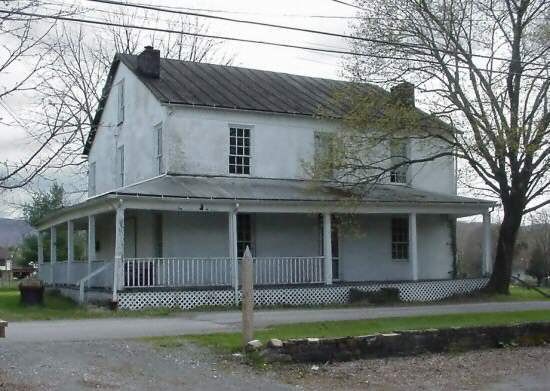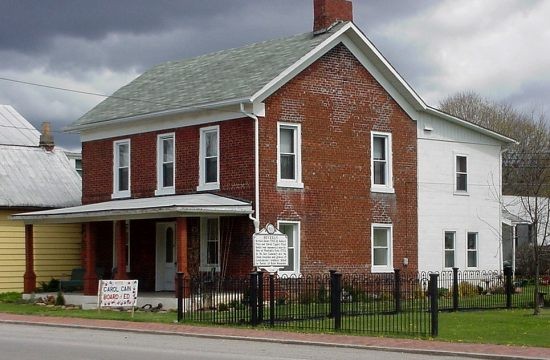Old Beverly Jail
Introduction
Text-to-speech Audio
Images
Beverly Jail on Walnut Street, constructed in 1841.

1813 Beverly Jail, frequent but short term host to Robert Ferguson.

John Hart, signer of the Declaration of Independence and father to Edward Hart (who constructed the first Beverly jail in 1790).

Backstory and Context
Text-to-speech Audio
Prior to the original jail’s construction in 1790, prisoners in the area of Beverly were held in the home of the sheriff. During the court session of 1789, however, local resident Edward Hart was awarded a contract for the building of a log structure on the west side of what is now Main Street to serve that purpose. Edward arrived to the area of Beverly from New Jersey after the conclusion of the American War of Independence. His father, John Hart, was a signer of the Declaration of Independence from that state. During the New Jersey campaign of 1776, Hart invited the Continental Army under General George Washington to camp on his farm in Hopewell and on at least one occasion dined with the commander-in-chief. In retaliation, British forces under General William Howe drove Hart and his family into hiding. After several months of living in caves and out in the open, Hart was able to return to his home in the wake of the Continental victory at Princeton on January 3, 1777. Unfortunately, in his absence British troops had destroyed his home and much of his property, and the months of hard living eventually caused Hart’s death in 1779. His sons Edward and Daniel traveled west, eventually settling in Beverly, where Edward completed construction on the town’s first jail. Though he was meant to complete the jail within a month, it eventually took a full year and the assistance of the sheriff in raising $26 for its completion (approximately $725 today).
Within a decade, this first jail proved unable to meet the needs of Beverly, which had grown considerably since becoming the seat of the new county of Randolph. So, in 1813, the court once more ordered the construction of a new jail, this time contracted to William Marteny and William Steers for the price of $250 (almost $3300 today). This new structure on the east side of Main Street was two stories tall with four-foot-deep foundations. Built of stone, it had four cells: two on the first floor for regular prisoners and two on the second floor for debtors, who were allowed to travel about town during the day. It was in this jail that local legend Robert Ferguson was housed after his frequent disruptions of the county court sessions across the street. Ferguson, a local farmer and Blacksmith, was known throughout town for having shod the horse of General George Washington during the Whiskey Rebellion while he was a resident of Greene County, Pennsylvania. Ferguson, who was reported to be six feet tall and weigh two hundred pounds, was also known locally for his feats of strength, being able to drink directly from whiskey barrels that he held aloft above his head and upon one occasion carrying the corpses of a bear, two cubs, and five turkeys home on his own after a hunting trip. By far his favorite hobby was to sit in attendance at the Old Beverly Courthouse and pass the time drinking, behavior that led to his arrest on a number of occasions after swearing at the judge and then subsequently swearing again once the judge had held him in contempt. Every time he was arrested and transported to the jail across the street he would return a few short minutes later with the bars of the cell window in his hands. He had, after all, been given the contract for manufacturing the bars and knew exactly how to remove them.
Like the 1790 jail, the 1813 structure eventually proved inadequate to Beverly’s needs as well. So, in 1841 Randolph County began construction on a third house for its inmates, this time on Walnut Street. This brick structure, built by William T. Clark and Alexander K. Holloway, contained two cells on the first floor and two on the second. One of the cells on the second floor was reserved for women prisoners and did not have bars, while the other on the second floor was an iron cage four feet smaller than the room itself that was used for dangerous prisoners and those with mental illnesses. This jail is especially notable for its association with J.F. Phares, the “bogus State Sheriff of Randolph County,” as Confederate sympathizers referred to him during the Civil War.[1] Phares was the sheriff of the county under the Reorganized or Provisional State of Virginia prior the formation of West Virginia in 1863, a Unionist that worked to maintain law and order for the federal government after the secession of Virginia from the United States. Phares played a particularly prominent role during the Jones-Imboden Raid of 1863.
The Jones-Imboden Raid was intended as a last-ditch effort by the Confederate Army to prevent the formation of West Virginia and secure the region once more for the Confederacy. In planning the campaign, Confederate General Robert E. Lee ordered Generals William E. Jones and John D. Imboden to target sheriffs like Phares in the hopes that they might disrupt the Unionist state government’s ability to enforce its authority. So, when Confederate troops reached the area of Beverly in 1863 they targeted Phares before reaching the town. Though they shot him through the lungs Phares was able to escape their grasp and reach Beverly in time to warn the Federal troops stationed there, who in turn were able to resist the Confederate advance long enough to warn their compatriots in the raiders’ ultimate destination of Philippi.
Through their association with individuals like Hart, Ferguson, and Phares, the jails of Beverly enjoy a unique series of connections to broader processes of US history. Windows into Revolutionary America, life in antebellum Appalachia, and the Civil War in West Virginia can all be found within a one block radius of the center of town. Visitors interested in this history can stop by the sites of the former jails or visit the Beverly Heritage Center nearby.
[1] Maxwell, 259.
Sources
“1841 Randolph County Jail.” Historic Beverly West Virginia. Historic Beverly Preservation, Inc. Accessed September 7, 2019. http://www.historicbeverly.org/builds/1841jail.htm.
“Beverly: A More Complete History (Part Two of Three).” Historic Beverly West Virginia. Historic Beverly Preservation, Inc. Accessed September 7, 2019. http://www.historicbeverly.org/wordpress/beverly-a-more-complete-history-part-two-of-three/.
Bosworth, Albert Squire. A History of Randolph County, West Virginia, from Its Earliest Exploration and Settlement to the Present Time. Elkins, WV, 1916.
Collins, Darrell L. The Jones-Imboden Raid: the Confederate Attempt to Destroy the Baltimore & Ohio Railroad and Retake West Virginia. Jefferson, NC: McFarland & Co., 2007.
Maxwell, Hu. The History of Randolph County, West Virginia. From Its Earliest Settlement to the Present, Embracing Records of All the Leading Families, Reminiscences and Traditions. Morgantown, WV: Acme Publishing Co., 1898.
“The 1813 Randolph County Jail.” Historic Beverly West Virginia. Historic Beverly Preservation, Inc. Accessed September 7, 2019. http://www.historicbeverly.org/builds/1813jail.htm.
Historic Beverly Preservation, Inc.
Historic Beverly Preservation, Inc.
Wikipedia
